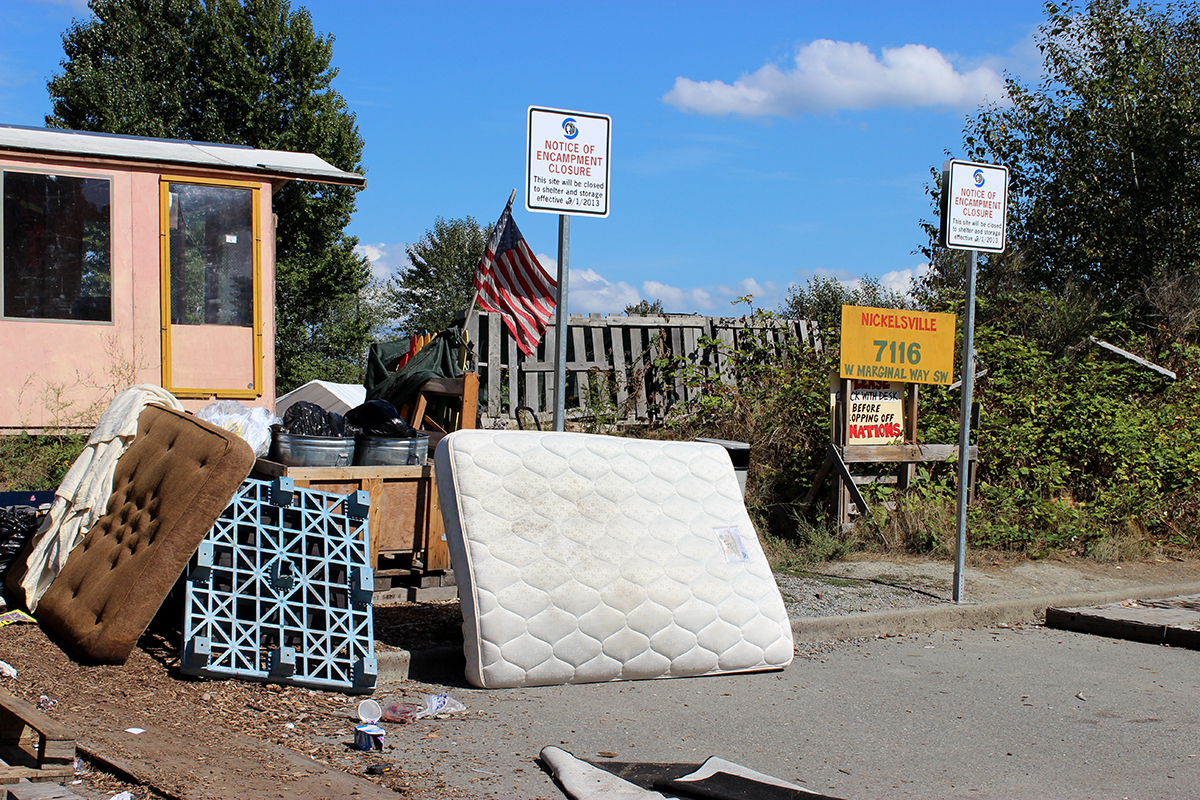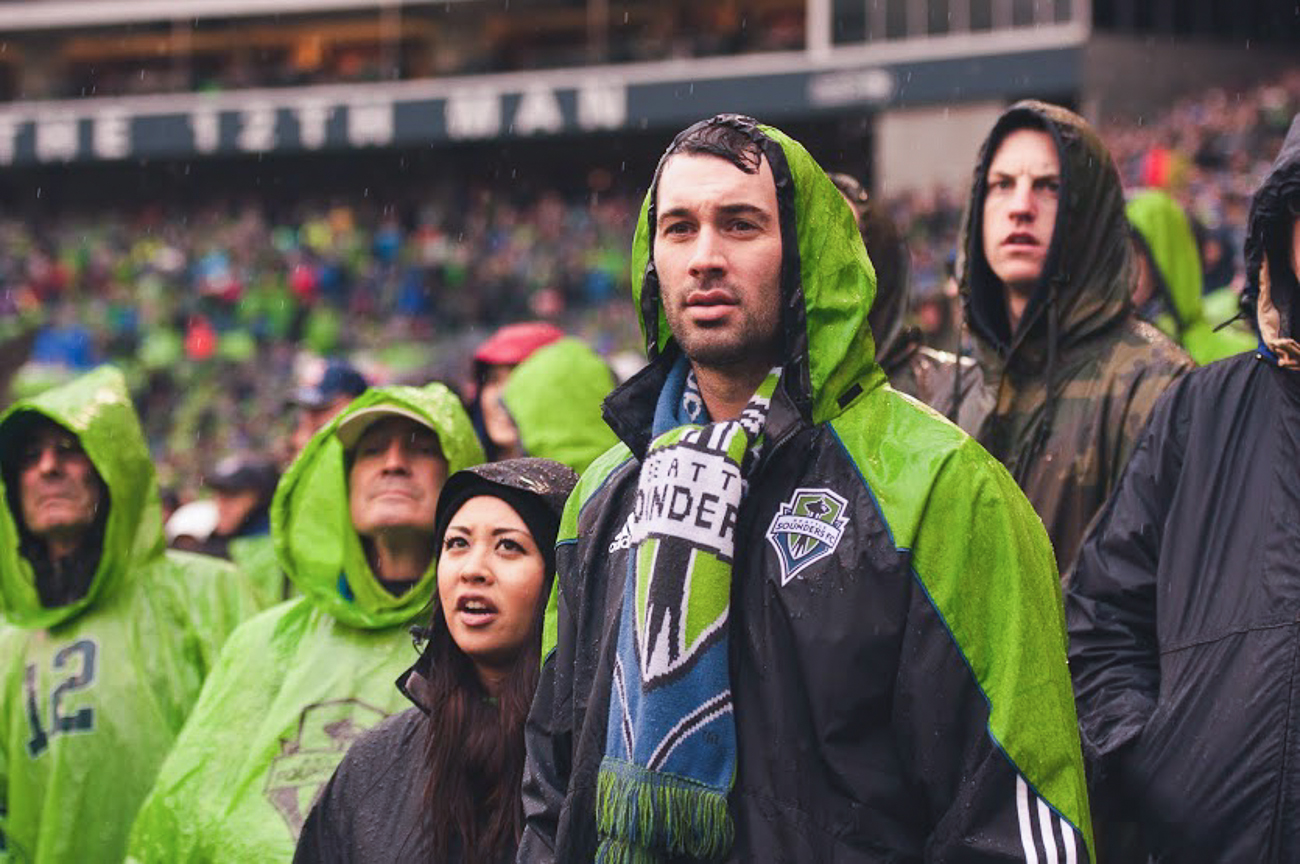On Sunday, in the middle of a three-day holiday weekend and as the City Council wrapped up a two-week vacation, the last campers at West Seattle’s Nickelsville packed up and moved out, prodded by a Sept. 1 eviction deadline handed down by the council in June.
Avoiding the photo op no one wanted—cops and bulldozers forcing Nickelodians off the city-owned land and into uncertainty—Nickelsville residents were able to secure three new locations at the last minute. Thanks to temporary permits and sympathetic private landowners like the Low Income Housing Institute, which offered land in the Central District at South Jackson Street and 20th Avenue South, the latest crisis for Nickelsville residents was averted, at least for the time being.
“It’s wonderful. We’ve got enough room for everyone” at the new locations, says Peggy Hotes, a liaison between Nickelsville and Jam for Justice, the nonprofit that sponsors the tent city. She says the move will make Nickelsville residents safer and provide stability. “We’re very happy that it’s all working out the way it is,” Hotes says of the move, while maintaining that the order that made it necessary was misguided and in many ways cruel.
Misguided or not, Nickelsville is closed, just as the council instructed, with a $500,000 general-fund check cut to the Union Gospel Mission to help relocate residents to more viable housing. With the council trumpeting compassion and citing Nickelsville safety concerns like rats and winter mud, and arguing that tent cities aren’t an effective solution to bring people out of homelessness, the contract with the Union Gospel Mission was signed quickly. There was no advertisement or bidding process, thanks to the tight time frame of the council’s eviction notice and a city ordinance that gives the Seattle Human Services Department the leeway to move fast in such situations.
While she’s excited about the move and the promise of a better future for tent-city residents, Hotes calls the Union Gospel effort a “disaster,” saying that the options offered by the Mission—which often included restrictions on pets or family types—“weren’t viable for a great number of people” living at Nickelsville.
A month after the 5-4 vote to shut down Nickelsville, Councilmember Tim Burgess expressed the victorious side’s view, writing on his blog: “When prevention efforts are not sufficient, the best strategy for dealing with homelessness—proven in many cities across the country—is to help people into permanent housing quickly. This is exactly what the Council directed in June when we authorized an additional $500,000 to help those living at the Nickelsville encampment in West Seattle find a place to live.”
But with three new smaller tent cities taking Nickelsville’s place, it’s worth wondering just what was gained and just how far that $500,000 went.
According to the Union Gospel Mission’s Terry Pallas, as of late last week 51 Nickelsville residents had been helped into more permanent housing, with “10 more in the pipeline.” Pallas says the majority of these former Nickelodians have been placed in furnished transitional apartments, while some have gone to drug treatment and domestic-violence safe houses. Eight received bus or train tickets out of town to reunite with friends or family members. Pallas has heard the critiques of the Mission’s effort, but remains adamant that the religious organization has done everything in its power to help. “From our end, with what we were tasked to do . . . we feel like it’s been a good model, because we’ve been able to serve so many different kinds of people,” says Pallas. A forthcoming Human Services Department review will likely be the final judge of that.
Complicating matters, the population at Nickelsville ballooned after word came down that the council intended to close it and was funneling money there to help people find housing. According to City Council President Sally Clark, in June Nickelsville had about 80 residents; recent estimates have put that number closer to 150. “One of the things you learn is when you put a half a million dollars in services out there, people will take notice,” says Clark.
Speaking last week, Pallas indicated that, working with the Sept. 1 deadline in mind, the Union Gospel Mission had already committed “a large majority of the [money].” Asked if he thought that money would be gone by the end of the Labor Day weekend, he said “It’s going to be pretty close.” The math is fairly straightforward: Relocating just over 60 former Nickelsville residents at a cost of roughly $500,000 breaks down to about $8,000 per person. With most of those placed in transitional apartments with year-long leases (by the fourth month, according to Pallas, newly housed former Nickelodians are expected to start contributing “a very small program fee”), $8,000 per person seems reasonable. According to Clark, if you consider that Nickelsville had roughly 80 residents when the Council acted and 60-some were helped, the operation’s success rate wasn’t bad. However, she also admits that gauging this success is “in the eye of the beholder.”
As skeptics will note, if the goal was to make a statement that Seattle is too compassionate to allow people to toil in encampments, it’s hard to view the effort as a win. Where once there was one big tent city, there are now three small ones. Sixty-some people were helped into some form of housing, but as Real Change executive director and longtime homeless advocate Tim Harris notes, for every person lifted out of Nickelsville, five more seemed to show up to take their place. “Even if Nickelsville does come up with, say, three sites that are suitable for 150 people to move to,” Harris opined last week, “then instead of one big unregulated camp, we’ve got three smaller camps dispersed throughout the city and no framework for how that can be supported through outreach and social services. . . . I don’t think anybody I knew thought that throwing $500,000 at this was going to be any kind of a long-term solution.”
What is the long-term solution, and how will the Council proceed now that the West Seattle Nickelsville is no more?
“It takes money,” says Clark. Likely a whole lot more than half a million dollars.
502 Wins. Does Medical Pot Lose?
Since the passage of Washington’s pot-legalizing I-502 last fall, the searing debate over how broad legalization and regulation would affect the state’s medical-cannabis users largely fell away as residents grappled with the new law’s more immediate implications.
But no longer. With last week’s announcement that the Department of Justice would not challenge I-502 as long as strict regulations were laid down on the use and distribution of marijuana, officials foreshadowed what’s sure to be a knock-down, drag-out fight over medical-marijuana policy in the upcoming legislative session, if not sooner.
The question is this: Does the state want, and will the federal government allow, two separate avenues for legal marijuana to exist in Washington, each with its own set of rules—or was Thursday’s announcement a signal that the Department of Justice wants I-502 to become the law of weed-land? This scenario has been floated since I-502 first made it onto the ballot, but U.S. District Attorney Jenny Durkan seemed to feed the paranoia Thursday with a brief statement on the DoJ’s statement: “The continued operation and proliferation of unregulated, for-profit entities outside of the state’s regulatory and licensing scheme is not tenable and violates both state and federal law.” Nobody had to ask which “entities” she was talking about, nor what “regulatory and licensing scheme.”
“She made it pretty clear that there’s no protection for medical marijuana,” says Keri Boiter, the head of a campaign called Health Before Happy Hour that is lobbying the state not to impair medical cannabis while crafting regulations for recreational use. “I don’t know if it’s pressure from her superiors or if she said, ‘Look, it’s easier to work with 502,’ but it’s not a workable system for patients.”
Most agree that Washington’s medical-marijuana industry is in need of tighter regulations, as Gov. Jay Inslee noted during a press conference following the Department of Justice announcement. “Even independent of today’s discussion, we believe there are serious changes that need to be brought to bear on medical marijuana for a variety of reasons,” he said. “That probably even predated the voter initiative. There’s some work to be done with medical marijuana.”
But medical-marijuana advocates contend that I-502 regulations are, to borrow a phrase, “untenable” for medical-cannabis users—especially the high taxes that will be levied on the drug under I-502. “The reaction the governor and Jenny Durkan are having to this is saying we have to prop up” I-502, says Doug Hiatt, a local lawyer who opposed I-502 (as did Boiter).
The governor’s office says it isn’t even close to committing to a course of action. As part of this year’s state budget, the Liquor Control Board was directed to study how, or if, I-502 and Washington’s medical-marijuana law could co-exist; that study is just beginning, says John Lane, Inslee’s senior policy adviser on public safety, and it’s too soon to say what the administration would support. “Yesterday’s announcement was just a reminder there’s a need to put regulations around the medical-marijuana market,” Lane says. daniel person
E
news@seattleweekly.com








